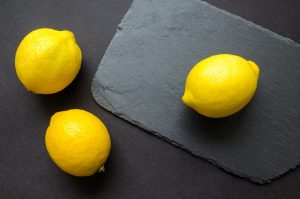Homeowners often ask how to get rid of garbage disposal odor.
Most homeowners and renters who have garbage disposals in their kitchen sinks eventually face the dreaded nightmare of some type of awful stench filling their kitchens and nearby rooms. Terrible garbage disposal smells often occur because of trapped food and oil, biofilm and mold inside the disposal and drainpipe. Running water into the disposal while you have it turned on typically isn’t a good enough solution because the common odor sources stick to the interior of it and the pipe. The only way to get rid of the smell is to thoroughly clean the disposal, use it in ways that reduce build-up, regularly maintain the entire system and better the overall indoor air:
RELATED POST: Bad Smell in the House? Follow Your Nose

Try These Garbage Disposal Cleaning Solutions
You can typically clean away any odor-causing debris by using a simple non-toxic and environmentally-friendly solution made of ingredients that most people have in their homes.
Mix together a half cup of dish soap and one cup cold water and pour it into the disposal. Wait five minutes and then rinse with cold water while running the disposal. If this cleaning solution fails to fix the problem, pour a cup of baking soda and a cup of vinegar down the drain, wait five minutes and then turn on the cold water and the disposal.
Another option: Use a half cup of small ice cubes, preferably made of a pleasant-smelling natural liquid with mildly acidic properties like lemon juice or vinegar, and a half cup of coarse sea salt and run cold tap water and the disposal for a few minutes.
Of course, natural solutions might not handle the problem, especially if there is a lot of build-ups because you haven’t cleaned the disposal in a while. Sometimes the only solution to this problem is a cleaning foam designed specifically for disposals and pipes and isn’t made of harsh chemicals that can damage seals. To use this solution, remove your garbage disposal’s rubber splash guard and then follow the product instructions.

Rethink How You Use the Disposal
People often incorrectly push or scrape cuttings, food scraps, meal waste and expired leftovers into the disposal, turn on the system and then run hot water down the drain. For starters, you should never put large pieces of food into the disposal. It works best when you cut them up into smaller ones it can manage. You should also never run the disposal dry since cold water helps the blades more smoothly slide through food waste. It’s better to use cold water because hot water promotes food expansion that leaves behind pieces of food and microorganism growth.
Additionally, only certain types of foods should be run through a garbage disposal. Many foods become stuck and smell as they rot and microorganisms that feed on the waste often release smelly gases.
Never use your disposal to deal with bones, grease or oil or foods that have a high concentration of starch that can make them expand and sticky and thicker when wet like potato peels or dry rice and pasta. You should also never use it to dispose of skins that can stick to the interior like onion and garlic skins or fibrous, stringy foods that can wrap around the blades like celery, corn husks, and kale. Instead, consider investing in a compost bin that you can fill with soil and earthworms and use for disposal of this waste to create nitrogen-rich fertilizer for your garden plants or to make a small side income by selling it to neighbors or gardeners.
Follow Through With Maintenance
One of the biggest reasons that odors return after initial thorough cleaning is because a homeowner or renter fails to stick with a cleaning and maintenance schedule. If you don’t need to use the disposal daily, you should run a few drops of dish soap and cold water down it and turn it on at least once a day. Otherwise, use dish soap and cold water at least once a week. If you use the disposal a lot every day, then you should substitute the weekly dish soap cleaning option with the ice cubes and coarse salt cleaning solution.
Don’t rely on the process of cleaning dishes as a substitute for performing this task separately. When people wash dishes by hand in a sink, the soap they use doesn’t always offset the amount of grease or oil that washes down the sink and sticks inside the disposal.
Alter the Surrounding Air Quality
Lastly, you can guarantee the improvement of the air quality around your disposal in different ways. For example, consider grinding up small pieces of sweet-smelling citrus rinds once a week or tap a pleasant-smelling spice like ground cloves at the top of the drain when it’s not in use. A small dish of potpourri placed near the sink can also fill the air with pleasant odors.
These options should never be used to “mask” unclean garbage disposal. Instead, they improve air quality in a kitchen that might have a slightly stale odor simply from a sink connected to older drainage pipes. To pull old odors out of the air, consider placing a small bowl of baking soda or volcanic rock pieces near the sink or invest in an air purifier.
Air purification systems are great for not only lasting disposal odors that persist in the air even after you clean but also for when you’re cooking and something burns or has a pungent odor that you don’t want to smell hours after a meal.
Justin Curtis is the creator of Mr. Garbage Disposal. He’s not a professional plumber but is quite the handyman. He’s an accountant who likes to work with his hands and live frugally outside of the office. After a garbage disposal breakdown at his home, he was surprised at the staggering cost of parts and repairs.
Therefore, he took it on himself to learn all about garbage disposals and share that knowledge with the world.



Comments are closed.